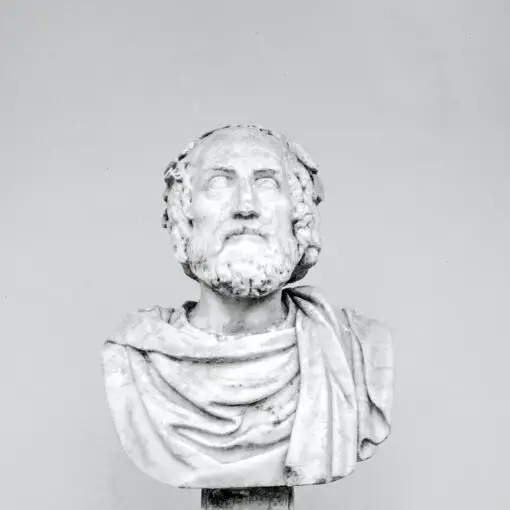At face value, it’s hard to determine exactly what the differences between stoicism and hedonism are. These two terms aren’t exactly clear, so it’s understandable why you could easily confuse the two schools of philosophy. This becomes even more convoluted as you begin to notice some of their similarities.
Although both schools of philosophy attempt to answer how we can live happily, hedonism and stoicism are different in how they view what’s important in life. They may have a similar goal but their approaches are completely different.
Before you get more confused, let’s take a second to break down these two terms. We’ll define what it means to be a stoic and also what it means to be a hedonist, then explore how these two schools of thought are different.
What it Means to be a Stoic
Stoicism is a school of thought developed in Ancient Greece during the 3rd century BCE by the philosopher Zeno of Citium. It falls under the category of Eudaimonic philosophy, meaning that it seeks to answer how we can live happily. At the time, though, happiness didn’t exactly mean what it means today.
For Greek philosophers, happiness came from living a virtuous life. For stoics, this meant following the rational rules of nature, knowing what you can and cannot control, and giving up care for the things that are beyond your power. Wisdom trumps passion to the point that intense feelings should be completely avoided.
Pleasure itself is not bad, but it’s not good either. Stoics viewed pleasure as a neutral and natural part of life that can be good as long as it’s in service of pursuing virtue. In fact, stoics label very few things as purely evil. Instead, they believe that life should be a quest for virtue, traveled upon a path set by the natural laws of the universe.
What it means to be a Hedonist
Hedonism, as a formal school of thought, can also be traced back to Ancient Greece where Epicurus first founded a hedonistic school of philosophy in the mid-300s BCE. Like stoicism, hedonism also falls under the umbrella of eudaimonic philosophy, meaning it seeks to find what makes life happy.
Hedonists had a completely different view of happiness, though. Whereas prior philosophers, such as Socrates, argued that happiness comes from living a virtuous life, hedonists argued that happiness comes from pleasure. Pleasure is the one true virtue in life and the more pleasure you seek, the happier you’ll be.
Hedonists even took this so far as to argue that pain was unvirtuous. They went out of their way to avoid pain and live in the most pleasurable way possible. To quote Epicurious:
“We recognize pleasure as the first good innate in us, and from pleasure we begin every act of choice and avoidance, and to pleasure we return again, using the feeling as the standard by which we judge every good.”
How the Two Schools Differ
Both schools of philosophy deal with finding happiness but they go about it in completely different ways. For the stoics, pleasure is nothing special. It’s neither virtuous nor unvirtuous. It’s simply a fact of life. They viewed it as something that should be treated indifferently.
Hedonists, on the other hand, view pleasure as the number one reason to live. To them, pleasure is the source of all virtue and happiness. And that doesn’t sound all bad, does it? Inherent in this idea, though, is a small paradox.
If your reason to live is to seek out pleasure, when will it ever be enough? Pleasure is fleeting and passes from moment to moment. The more you have of it, the more you want. Essentially, hedonism leads you down a path to chasing the dragon, trying to find the next thing to make you happy. Inversely, the constant search for happiness eventually leads to suffering.
Stoicism as a Response to Hedonism
If you take a hedonistic approach to life and make pleasure your sole goal, you are sure to exhaust the things that make you happy at some point. Stoicism presents an alternate perspective to this. While they view pleasure as a natural part of life, stoics also believe the same about pain. Pain is natural and bound to happen at some point.
Instead of stressing about the inevitable facts of life, stoics believe it’s better to manage the things you can control. Pain and pleasure come and go, often without our say, so why try to control them when you could just flow with the natural, rational nature of the universe. Rather than seeking pleasure out, experience as it naturally arises.
Stoicism also comes with a level of detachment. Where hedonism leads to a path of chasing the dragon, stoicism recognizes that pleasure can be addictive. When we become overly attached to our physical or emotional satisfaction, we give ourselves over to the external physical world. We can no longer directly control the things that make us happy because they are outside of us.
Eventually, though, those attachments will lead us to unhappiness. To a stoic, we shouldn’t allow external things to have so much control over our lives when they’re something we can actually manage.
Summing Up the Difference Between Stoicism and Hedonism
To put it succinctly, the main difference between stoicism and hedonism is the way we manage and approach pain and pleasure. Stoics understand that we often cannot control the entirety of our lives. We find happiness by managing what we can control and not caring so much about the things we can’t. This includes pain and pleasure.
Hedonists view life the opposite way. Pleasure is the greatest virtue in life and should guide us in our decisions. Whatever makes you happy, makes you happy. If it causes pain, avoid it and cut it out of your life. However, be careful following this train of thought. As the stoics point out, too much of a good thing can lead to unhappiness.
References
https://www.utilitarianism.com/hedonism.html
https://www.pursuit-of-happiness.org/history-of-happiness/epicurus/
https://www.worldhistory.org/Zeno_of_Citium/
https://www.thoughtco.com/stoics-and-moral-philosophy-4068536





